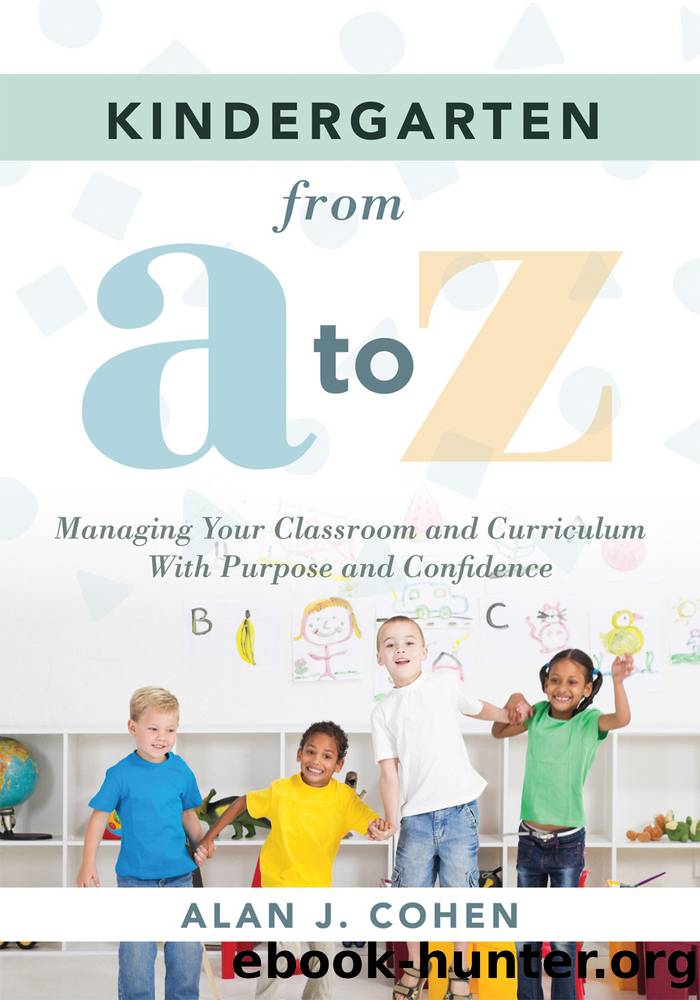Kindergarten from a to Z by Cohen Alan J.;

Author:Cohen, Alan J.;
Language: eng
Format: epub
Publisher: Solution Tree
Published: 2020-08-15T00:00:00+00:00
Station Numbers and Options
To have a successful choice time that students look forward to and excel in, you have to have many more choices than there are students. The one-child-one-choice model simply does not work. What if you went to a diner with two other people and there were three plates in front of the three of youâone was chicken, one was beef, and one was vegetarian? The waiter asks one of you to choose a plate, then asks the second person to choose, and of course, the third has no choice at all.
Children can play. Children will play. Children are play.
My general rule is double the total number of students in the class to figure out how many play spots the room needs. If I have twenty-one students in my class, I have eleven different activity areas for them to choose from and a total of forty spots available every day. I would have more if I couldâve thought of a way to do that. I offer the following options as well as others.
⢠Manipulatives: I spend time trying to find new educational, open-ended, and challenging manipulatives. I now have a kid-tested collection, including Magna Tiles, Gear Builders, Snap and Build Blocks, and Marble Run. I have been around a lot of toys in my career and am always finding new ones for choice time. Lakeshore Learning (www.lakeshorelearning.com) and Constructive Playthings (https://constructiveplaythings.com) are popular and good resources to start with. You can also put out almost any of your mathematics manipulatives (page 197). Watch as students reinforce and extend the concepts that you have taught with them or retool the manipulatives for a use you never dreamed of.
⢠Sand or water tables: Why do children love the beach? The beach is just one big sand table that is connected to a big water table. I have separate sand and water tables and students often cite them as not only as their favorite choice time activities but their favorite school activities of all. I embrace the sandy and watery mess when they are engaged in communal play that accentuates mathematical skills such as measuring and volume. It is a small price to pay for such engaged learning.
⢠Toy garage, farm, or playhouse: I have one of each. I can add almost any small manipulativeâanimals, people, counters, craft sticks, or cotton balls (to name but a few)âand students will connect it to these settings in the most creative ways.
⢠SMART Board: I have transformed the SMART Board into a play area for two by simply letting students access its paint feature so that they have a big electronic canvas to be creative with. They can also access educational programs such as ABCYa (www.abcya.com), Raz-Kids (www.raz-kids.com), and Starfall (www.starfall.com) on the SMART Board.
⢠Computers: These consist of four laptops on a table that have access to open-ended educational games in literacy, mathematics, music, and art programs. It is a very social area, and students do all the things we hope that they
Download
This site does not store any files on its server. We only index and link to content provided by other sites. Please contact the content providers to delete copyright contents if any and email us, we'll remove relevant links or contents immediately.
I'm the Teacher, You're the Student by Allitt Patrick;(192)
Competing on Culture by VanWagoner Randall;Sydow Debbie L.;Alfred Richard L.;(169)
Teaching Skills For Dummies by Sue Cowley(156)
The Art & Science of Web Design by Jeffery Veen(150)
Maker-Centered Learning by unknow(131)
People Skills by Thompson Neil(127)
Lorange P. Learning and Teaching Business...Lessons...2022 by Unknown(121)
Managing Unstoppable Learning by Hierck Tom;(118)
Motivating Defiant and Disruptive Students to Learn by Rich Korb(114)
Connecting Through Leadership by Kullar Jasmine K.;(108)
The InterActive Classroom by Nash Ron;(108)
Forces of Influence by Ende Fred;Everette Meghan;(107)
Academic Advising and the First College Year by Jenny R. Fox; Holly E. Martin(103)
What We Say and How We Say It Matter by Mike Anderson(102)
Summarization in Any Subject by Wormeli Rick;Stafford Dedra;(102)
Teacher Mentoring and Induction by Portner Hal;(102)
Employee of the Month by Tracey Rogers(101)
Teaching Behavior by Terrance M. Scott(96)
Leveraging Data for Student Success : Improving Education Through Data-Driven Decisions by Laura G. Knapp; Elizabeth Glennie; Karen J. Charles(96)
